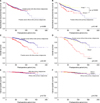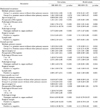1. Cooperberg MR, Lubeck DP, Mehta SS, Carroll PR. CaPSURE. Time trends in clinical risk stratification for prostate cancer: implications for outcomes (data from CaPSURE). J Urol. 2003; 170(6 Pt 2):S21–S25.
2. Schroder FH, Hugosson J, Roobol MJ, Tammela TL, Ciatto S, Nelen V, et al. Screening and prostate-cancer mortality in a randomized European study. N Engl J Med. 2009; 360:1320–1328.
3. Hayat MJ, Howlader N, Reichman ME, Edwards BK. Cancer statistics, trends, and multiple primary cancer analyses from the Surveillance, Epidemiology, and End Results (SEER) Program. Oncologist. 2007; 12:20–37.
4. Engeland A, Bjorge T, Haldorsen T, Tretli S. Use of multiple primary cancers to indicate associations between smoking and cancer incidence: an analysis of 500,000 cancer cases diagnosed in Norway during 1953-93. Int J Cancer. 1997; 70:401–407.
5. Mydlo JH, Gerstein M. Patients with urologic cancer and other nonurologic malignancies: analysis of a sample and review of the literature. Urology. 2001; 58:864–869.
6. Ray P, Sharifi R, Ortolano V, Guinan P. Involvement of the genitourinary system in multiple primary malignant neoplasms: a review. J Clin Oncol. 1983; 1:574–581.
7. Kinoshita Y, Singh A, Rovito PM Jr, Wang CY, Haas GP. Double primary cancers of the prostate and bladder: a literature review. Clin Prostate Cancer. 2004; 3:83–86.
8. Nakata S, Kato J, Sato J, Mayuzumi T, Kumasaka F, Shimizu T. Analysis of multiple primary cancers in patients with urologic cancer. Int J Clin Oncol. 1997; 2:40–46.
9. Antonelli A, Calza S, Arrighi N, Zani D, Corti S, Cozzoli A, et al. Clinical features and prognosis of patients with renal cancer and a second malignancy. Urol Oncol. 2012; 30:294–300.
10. Rabbani F, Grimaldi G, Russo P. Multiple primary malignancies in renal cell carcinoma. J Urol. 1998; 160:1255–1259.
11. Pawlish KS, Schottenfeld D, Severson R, Montie JE. Risk of multiple primary cancers in prostate cancer patients in the Detroit metropolitan area: a retrospective cohort study. Prostate. 1997; 33:75–86.
12. Pandha HS, Waxman J. Multiple primary cancers in association with prostate cancer. Cancer Surv. 1995; 23:235–246.
13. Kawakami S, Fukui I, Yonese J, Ueda T, Ohno Y, Tsuzuki M, et al. Multiple primary malignant neoplasms associated with prostate cancer in 312 consecutive cases. Urol Int. 1997; 59:243–247.
14. Epstein JI, Amin M, Boccon-Gibod L, Egevad L, Humphrey PA, Mikuz G, et al. Prognostic factors and reporting of prostate carcinoma in radical prostatectomy and pelvic lymphadenectomy specimens. Scand J Urol Nephrol Suppl. 2005; (216):34–63.
15. Greene FL. The American Joint Committee on Cancer: updating the strategies in cancer staging. Bull Am Coll Surg. 2002; 87:13–15.
16. Murphy GP, Busch C, Abrahamsson PA, Epstein JI, McNeal JE, Miller GJ, et al. Histopathology of localized prostate cancer. Consensus Conference on Diagnosis and Prognostic Parameters in Localized Prostate Cancer. Stockholm, Sweden, May 12-13, 1993. Scand J Urol Nephrol Suppl. 1994; 162:7–42.
17. Cookson MS, Aus G, Burnett AL, Canby-Hagino ED, D'Amico AV, Dmochowski RR, et al. Variation in the definition of biochemical recurrence in patients treated for localized prostate cancer: the American Urological Association Prostate Guidelines for Localized Prostate Cancer Update Panel report and recommendations for a standard in the reporting of surgical outcomes. J Urol. 2007; 177:540–545.
18. Warren S, Gates O. Multiple primary malignant tumors: a survey of the literature and a statistical study. Am J Cancer. 1932; 16:1358–1414.
19. Mydlo JH, Agins JA, Donohoe J, Grob BM. A review of urologic cancer patients with multiple primary malignancies. World J Urol. 2001; 19:240–243.
20. Trichopoulos D, Li FP, Hunter DJ. What causes cancer? Sci Am. 1996; 275:80–87.
21. Matzkin H, Braf Z. Multiple primary malignant neoplasms in the genitourinary tract: occurrence and etiology. J Urol. 1989; 142:1–12.
22. Jemal A, Siegel R, Xu J, Ward E. Cancer statistics, 2010. CA Cancer J Clin. 2010; 60:277–300.
23. Jung KW, Park S, Kong HJ, Won YJ, Lee JY, Park EC, et al. Cancer statistics in Korea: incidence, mortality, survival, and prevalence in 2008. Cancer Res Treat. 2011; 43:1–11.
24. Park SK, Sakoda LC, Kang D, Chokkalingam AP, Lee E, Shin HR, et al. Rising prostate cancer rates in South Korea. Prostate. 2006; 66:1285–1291.
25. Erickson KL, Hubbard NE. A possible mechanism by which dietary fat can alter tumorigenesis: lipid modulation of macrophages function. Adv Exp Med Biol. 1994; 364:67–81.
26. Luciani A, Balducci L. Multiple primary malignancies. Semin Oncol. 2004; 31:264–273.







 PDF
PDF ePub
ePub Citation
Citation Print
Print



 XML Download
XML Download